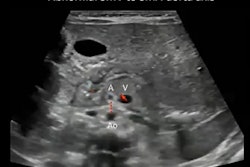
Point-of-care-ultrasound (POCUS) in combination with a decision-support checklist can help accurately diagnose transient synovitis in pediatric patients, according to research published July 13 in JAMA Network Open.
A group led by Marah Zoabi, a research assistant from the Technion-Israel Institute of Technology in Haifa, found that a POCUS decision-support algorithm can help provide more efficient diagnosis of transient synovitis and avoid unnecessary blood tests.
"To our knowledge, this study is the first to suggest a rule-in diagnostic tool for transient synovitis, instead of one of exclusion," Zoabi and colleagues wrote. "The traditional approach advocates the use of laboratory tests to differentiate between transient synovitis and other serious diseases."
Transient synovitis causes acute hip pain and is confirmed by excluding other severe diseases, such as septic arthritis, osteomyelitis, and Legg-Calvé-Perthes disease. Hip effusion, meanwhile, is typically found using ultrasonography.
The team's POCUS decision-support algorithm is used regularly to identify transient synovitis in pediatric patients. It includes a set of five clinical criteria that must be met, followed by bedside ultrasonography of the hip joint. The criteria include the following:
- Age 3-10 years
- Fever less than 38° C
- Pain with weight-bearing movement
- Concerns started seven days ago or earlier
- Absence of paleness, splenomegaly, and generalized lymphadenopathy
The researchers wanted to test the accuracy of the algorithm in diagnosing the disease. To do so, they looked at data gathered from 1,461 children with nontraumatic hip tenderness between October and November 2020.
The POCUS algorithm was applied to 621 patients (429 boys, 192 girls) with an average age of 5.5 years. Out of these patients, 539 were correctly diagnosed as having transient synovitis. Meanwhile, 22 patients were correctly diagnosed as not having synovitis and 54 were misdiagnosed as not having synovitis, but they were correctly diagnosed at follow-up visits.
Six emergency department patients were misdiagnosed as having synovitis, but they were found to have another condition at follow-up visits.
The algorithm showed high sensitivity at 90.9% and high positive predictive value at 98.9%. Specificity, meanwhile, was 78.6% and negative predictive value was 28.9%.
The algorithm's positive likelihood ratio of 4.25 suggests it can be helpful in ruling in the diagnosis of transient synovitis, the authors concluded.
Hip effusion may not always be present when patients present with transient synovitis. This is reflected by the limited specificity and low negative predictive value, suggesting the algorithm cannot reliably rule out synovitis, they added.
Potential limitations of the study included its retrospective nature, the operator-dependent nature of the ultrasonography exam, the absence of an objective reference standard, and the lack of external validation of the algorithm, according to Zoabi and colleagues.
However, "these data provide evidence for the safety of the POCUS decision-support algorithm," they wrote.


















